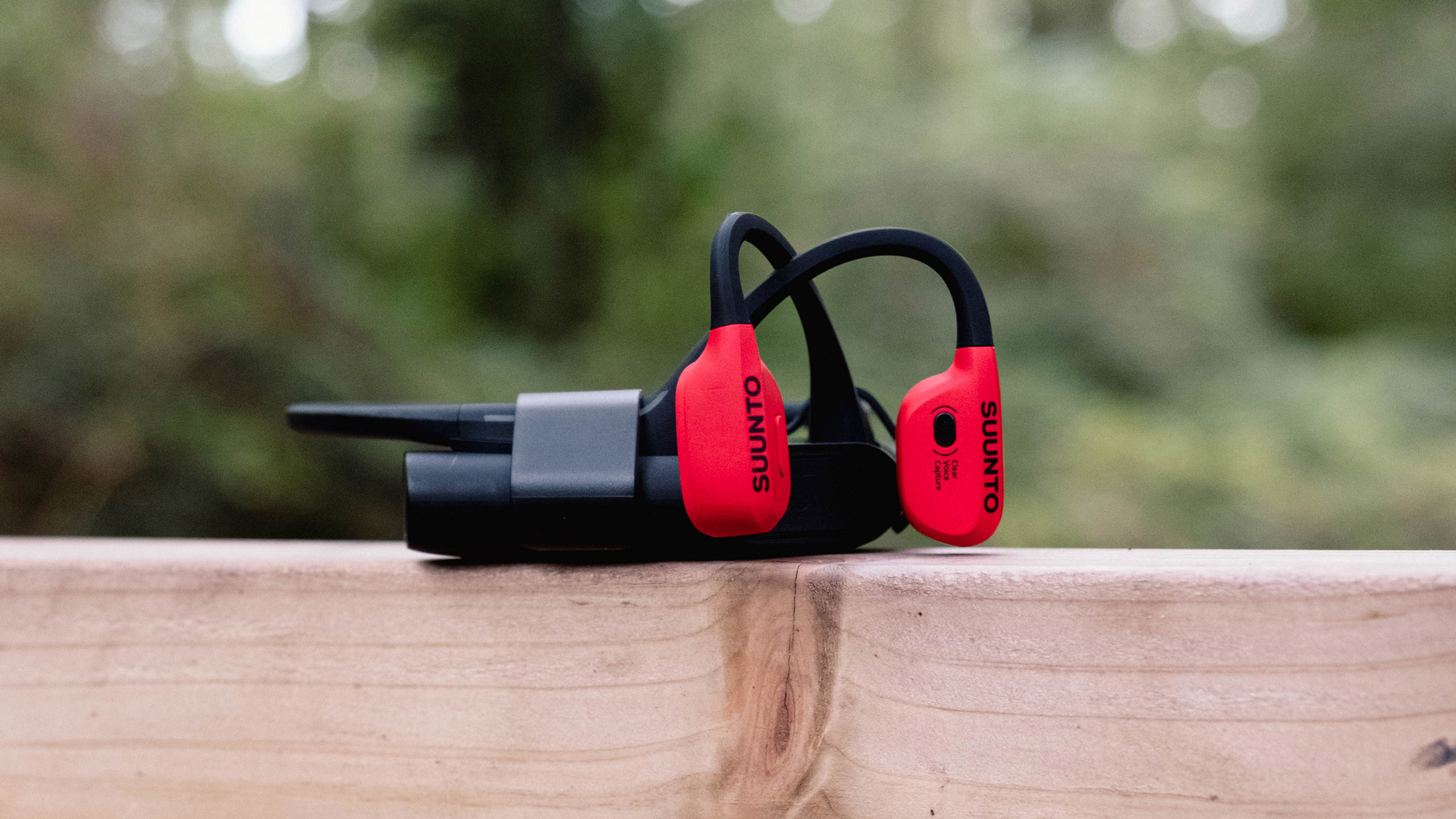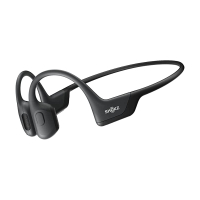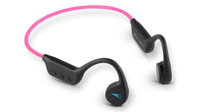TechRadar Verdict
Suunto may not have solved the issue of sub-standard sound quality that blights the open-ear, bone conduction headphone world, but its Wing offers a substantial battery life and the sort of outdoors robustness that Suunto is famed for. If open-ear technology is the only way you want to go, these might just be some of the best out there.
Pros
- +
Excellent design and fit
- +
Additional LEDs for improved visibility
- +
Lengthy battery life
- +
Innovative portable charging dock
Cons
- -
Sound quality isn’t great
- -
Buds prone to shifting
- -
Slightly more expensive than rivals
Why you can trust TechRadar
Suunto Wing: One minute review
Wing is Finnish brand Suunto’s first foray into the best bone conduction headphones market, and while it may be dominated by Shokz (formerly AfterShokz), there is clearly room for more players here.
Suunto is best known for making some of the best running watches, including the Suunto 9 Peak Pro, and it brings with it a wealth of outdoor experience which really shows in Wing. It’s well-designed in that it feels tough and built to withstand whatever you can throw at it.
The addition of a carry-case that doubles up as a charger is brilliant, as it extends battery life to more than 20 hours, which is perfect for ultra-endurance athletes or off-grid enthusiasts. It’s unusual to find in connected bone conduction headsets, and it’s nice to see tech common in the best workout earbuds make its way here.
Plus, the decision to place customizable LED safety lights at the flanks is proof that Suunto really understands its audience. These are people trail-running in the wilderness or forging new pathways at the weekends.
The biggest issue facing bone conduction technology is the sound quality and anyone making the leap from respected in-ear or over-ear headphones will likely be disappointed. But the additional spatial awareness afforded by open-ear headphones designed for outdoor sports unfortunately comes with a little audio quality compromise and it is the same story here.
Suunto Wing: Specifications
| Component | Suunto Wing |
| Price | $199 / £169 / AUS $319 |
| Weight | 33g / 16oz |
| Case material | Silicone & titanium alloy |
| Battery life | 4 hours, 30 hours with case |
| Water resistance | IP67 |
| Bluetooth range | >10m |
| Supported audio formats | A2DP, AVRCP, HFP, HSP |
Suunto Wing: Price and availability
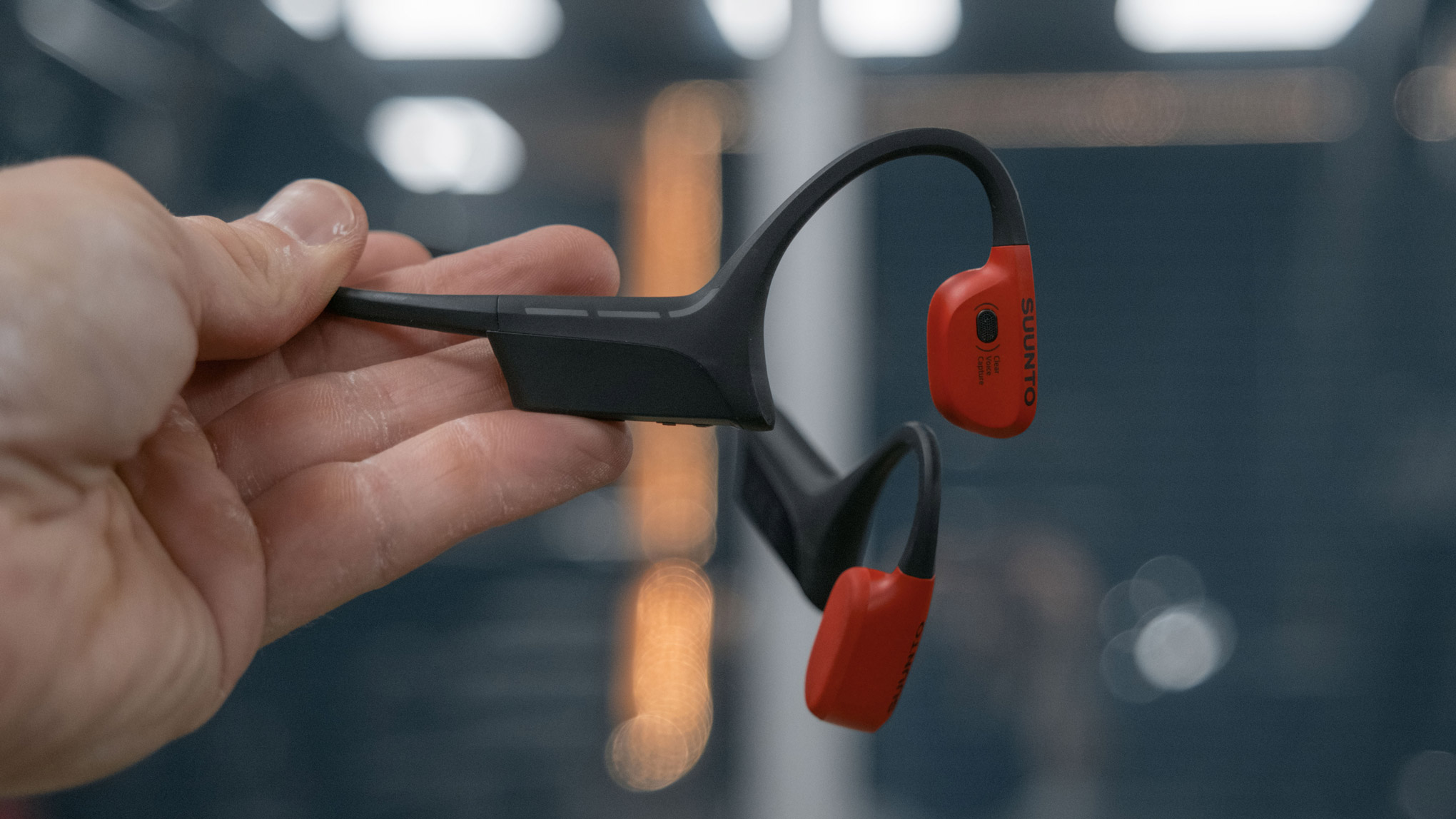
- $199 in the US
- £169 in the UK
- AUS $319 in Australia
Suunto Wing is, quite predictably, available to buy from the brand’s own website, where it retails at $199 / £169 / AUS $319.
Suunto also sells via online retailers, such as Amazon, although stock has been a little patchy at time of writing. Failing that, it is also available via some outdoors and sports retailers, such as BikeInn, but prices are standardized across the board, so it’s currently tricky to find a bargain.
The only variable available to the customer is color, with Suunto Wing coming in either a stealthy all-black offering or a slightly more noticeable black and red. Both pack the same price tag: more than the Shokz OpenRun Pro, its nearest competitor.
- Value score: 3/5
Suunto WIng: Design
- Lightweight, tough titanium alloy structure
- Three-button controls
- Bold design, attractive red colorway
Most bone conduction headphones look largely the same: the general theme sees two buds that sit just in front of the ear, conjoined by some sort of metallic band that is covered in a softer material so it doesn’t rub on the back of the neck.
To that extent, the design of the Suunto Wing is nothing revolutionary, but it feels altogether more premium as soon as you lift it out of the equally bougie box. The Suunto branding is bold and the color choice looks good, particularly with the red highlights on the model that I tested.
Suunto opts for a titanium alloy structure, covered in soft silicone, for its band, which proves both lightweight and tough. The buds that conduct sound to the inner ear via a series of vibrations are also covered in soft silicone and feel comfortable against the skin.
Control is taken care of by a trio of buttons that, although small, are easy to locate once familiar with the system. The main multi-function button on the right-hand earbud takes care of most functionality, as it is possible to answer calls, play music, and skip tracks with a combination of clicks.
Arguably coolest of all are the three red LEDs that sit on either side of Wing, which can be turned on or off (or cycled through the various flashing modes) by long-holding the volume down button, or through the Suunto smartphone app when the headphones are paired. For some reason, it reminded me of The Predator’s laser-targeting vision.
Finally, and perhaps what sets Suunto apart from rivals, is the unique charging dock that not only stores the headphones neatly when not in use, but also adds additional battery power every time the Wing is mounted. It’s a slick piece of design that features its own red LED lights that reveal the charge level of both the dock and the headphones.
- Design score: 4/5
Suunto Wing: Features
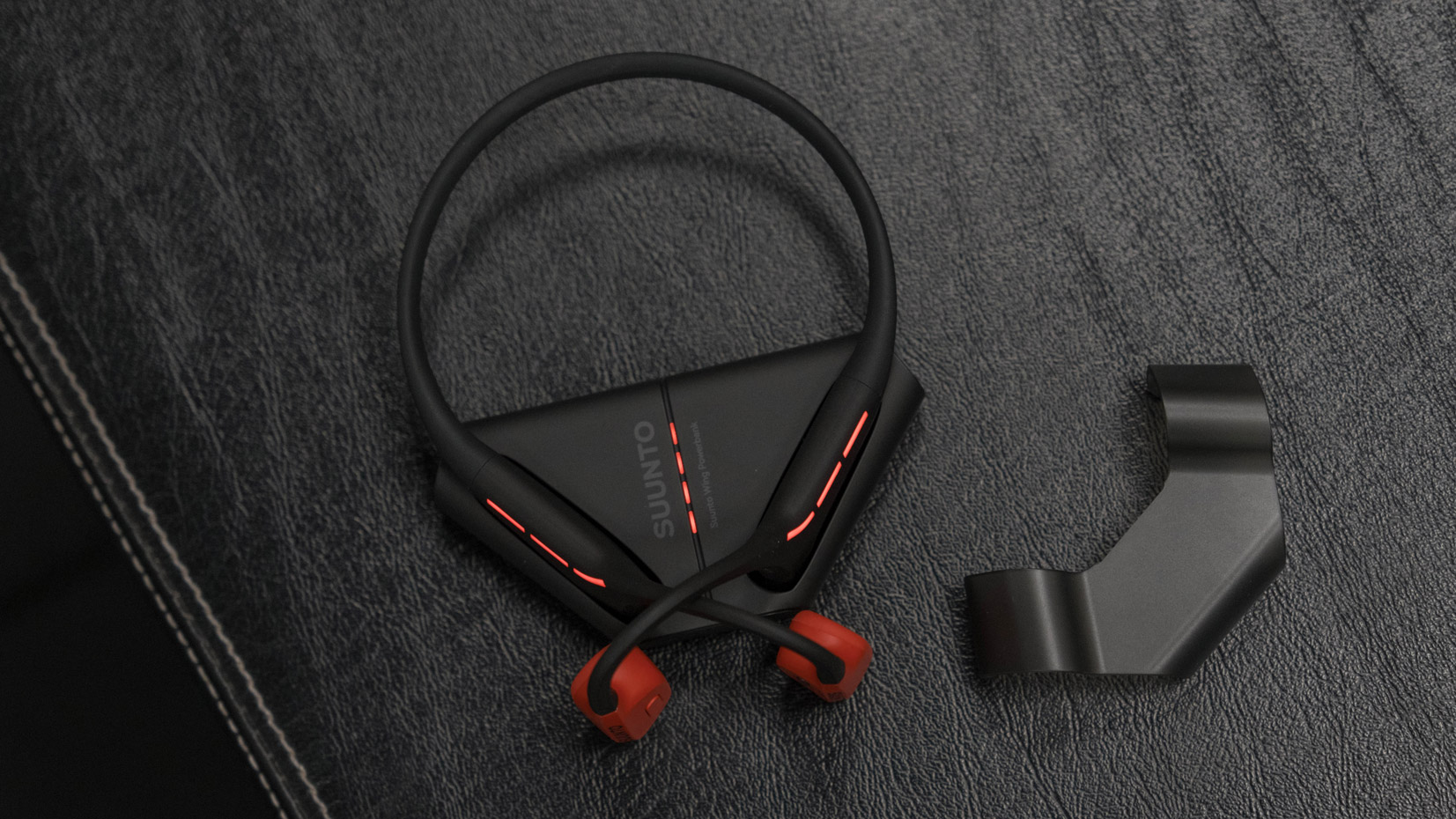
- 20Hz bone conductive technology
- IP67 water resistance rating
- Three hours of audio on 10-minute charge
The technology that powers Suunto Wing is housed within the two buds at the end of the band. These then sit on the jawbone of the wearer and send frequencies in the range of 20Hz~20kHz through the bone structure and into the inner ear.
This leaves the ear canal open to natural sounds from the environment, making bone conduction technology a lot safer to use when you need your wits about you - i.e. trail running or even cycling on a busy road.
Built tough, the Wing has been IP67 rated for water, dust and muck resistance, meaning they can be submerged in water up to a maximum depth of 10m for around 30 minutes. Granted, they aren’t fully waterproof and as such, aren’t sold as a device to lap the local pool in, but can handle most other situations. Suunto has also implemented a microphone into the design, which allows the wearer to make and receive hands-free calls.
There is also head movement control that gives the option to answer or reject incoming calls and skip tracks with various head movements, like nodding or shaking your noggin. This is fully controllable through Suunto’s smartphone app and you can easily turn the feature off if you don’t like it.
Again, the power bank that comes with the Suunto Wing is fairly novel, as it adds a further 20 hours of music playtime to an already impressive battery life and delivers three hours of audio via a quick 10-minute charge. It’s small enough, unobtrusive and designed to fend off the worst of the elements, so can be shoved in a backpack or bundled into some bike luggage and taken along for the adventure.
- Features score: 4/5
Suunto Wing: Performance
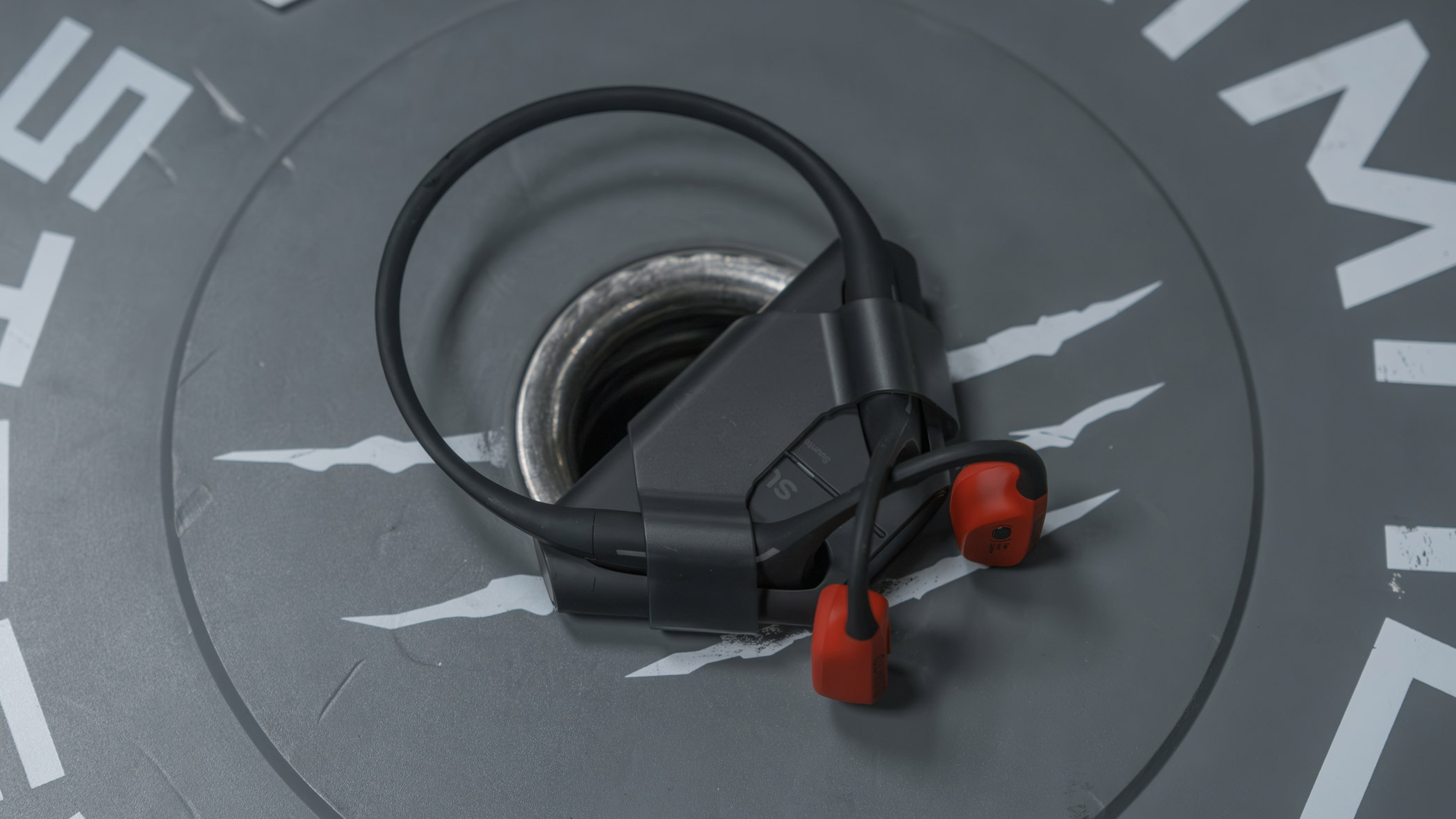
- Better audio than Shokz
- Tangible vibration
- Fends off rain
If you test Suunto Wing back-to-back with its closest rival, which in this case is arguably the Shokz OpenRun Pro in terms of price and features, Suunto’s offering comes out on top of the audio quality battle.
Bass is handled better and the overall experience isn’t as tinny. But let’s be real, the sound quality is still pretty bad. I found that I had to pump music up to high volumes to hear it over the general noise of traffic or the rush of trees flowing past on a gravel ride.
The brain is clever, and it tunes into the bone conduction technology after a few minutes, doing its best to block out ambient noise until it is required, but I still couldn’t get into my favourite musical tracks and playlists.
Instead, I opted to binge podcasts and audiobooks as a preferred distraction when out on a boring run or long hike. The sonic spectrum of a podcast is more limited than, say, a Slipknot track, so I found it much easier to tune into. With music, I found my brain tuned out after a while and often stopped listening altogether, with music becoming a sort of faint backing track.
Another issue that blights bone conduction technology is increased tangible vibration at higher volume. In other words, you can physically feel the headphones shake if you turn things up too loud, which can be off-putting.
In terms of fit, I found them comfortable and secure. The design is such that they don’t bounce or rub around the back of the neck when jogging, trail running or participating in other energetic tasks. They are also tough, and will withstand a fair amount of rolling around the bottom of a gym bag without worrying about providing an additional carry case.
With regards to water-proofing, I didn’t want to test these in a pool, seeing as they are not really marketed as waterproof headphones, but the IP67 rating states it can happily undergo “short periods of immersion”. I can say they will happily fend off a deluge when you are out running. In fact, I can’t remember a run I’ve been on in the last month that hasn’t been damp and dismal.
- Performance score: 5/5
Suunto Wing: Scorecard
| Category | Comment | Score |
| Value | It’s certainly not the cheapest pair of bone conduction headphones out there but the build quality is great. | 3/5 |
| Design | Slick looks and that additional charging dock is a bonus. But nothing revolutionary. | 4/5 |
| Features | Hands-free calling and the ability to interact with head movement make this a winner. | 4/5 |
| Performance | Good sound for open-ear headphones, excellent battery life and solid construction. | 5/5 |
| Total | A worthy Shokz rival and a great pair of bone conduction headphones overall. | 4/5 |
Suunto Wing: Should I buy?
Buy it if...
You run, cycle or exercise outdoors
Open-ear technology is a lot safer than pugging your ear canals with headphones and essentially killing off on of your sense.
You want to keep things light
The Suunto Wing disappears on the head after a few minutes. So much so, you’ll barely notice it is there.
Battery life is key
The additional charging dock is perfect for those venturing off-grid and sees battery life outperform plenty of headphone rivals, open ear or not.
Don't buy it if...
You appreciate sound quality
Bass-heavy dance tunes and blaring heavy metal will not be done justice by these headphones. If you prefer music as background noise, or want to indulge in podcasts and audiobooks, they are fine.
You want a diminutive package
Although lightweight and relatively small, the Suunto Wing can’t compete with something like Apple’s AirPods in terms of pocketable size.
Cancelling noise is a dealbreaker
Although Suunto offers a pair of foam earplugs in the box, if you need to block out the sound of a screaming baby, look elsewhere.
Also consider
| Component | Suunto Wing | Shokz OpenRun Pro | H20 Audio Tri Multi-SPort |
| Price | $199 / £169 / AUS $319 | $179.95 / £159.95 / AUS $319 | $149.99 / £129 / AUS $225 |
| Weight | 33g | 29g | 33g |
| Case material | Silicone & titanium alloy | Silicone & titanium | Plastic |
| Battery life | 4 hours, 30 hours with case | 10 hours | 7 hours |
| Water resistance | IP67 | IP55 | IPX8 |
| Bluetooth range | >10m | >10m | N/A |
| Supported audio formats | A2DP, AVRCP, HFP, HSP | A2DP, AVRCP, HFP, HSP | MP3, WMA, and Apple iTunes’ M4A |

Leon has been navigating a world where automotive and tech collide for almost 20 years, reporting on everything from in-car entertainment to robotised manufacturing plants. Currently, EVs are the focus of his attentions, but give it a few years and it will be electric vertical take-off and landing craft. Outside of work hours, he can be found tinkering with distinctly analogue motorcycles, because electric motors are no replacement for an old Honda inline four.
